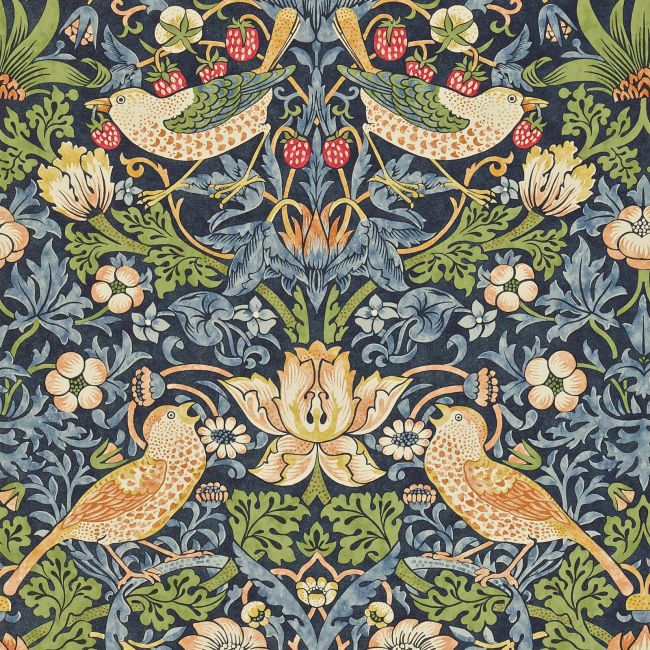
Strawberry Thief, 1883
William Morris’ "Strawberry Thief" is one of the most iconic textile designs of the Arts and Crafts Movement, created in 1883. Renowned for his mastery in decorative arts, Morris drew inspiration from nature and medieval art, and his work often reflected a desire to elevate traditional craftsmanship.
The "Strawberry Thief" design is a perfect example of this philosophy. It features an intricate, repeating pattern of birds, leaves, and berries. The central motif depicts thrushes—commonly referred to as "strawberry thieves"—stealing fruit from strawberry plants. Morris was inspired by the sight of these birds in the garden of his countryside home, Kelmscott Manor, where they frequently visited to steal strawberries from his kitchen garden.
Crafted using the labor-intensive technique of indigo discharge printing, the fabric showcases Morris' attention to detail and love of complex, natural forms. In this process, indigo dye is applied to the fabric, and then areas are carefully treated to remove the dye where the pattern will appear, resulting in the rich, multi-tonal design. This was an innovative and costly method for fabric production at the time, but it allowed for the intricate detailing and vibrant colors that Morris cherished.
The balance of nature and stylization in "Strawberry Thief" embodies Morris' passion for medieval and Islamic art, particularly their use of symmetry and floral motifs. The flowing lines of the leaves, the delicate placement of the birds, and the vivid interplay of colors—ranging from deep blues and greens to rich reds—create a tapestry of visual harmony. The design combines artistic beauty with a narrative charm, illustrating a story of nature's whimsy.
"Strawberry Thief" was originally designed as a furnishing fabric, intended for curtains or upholstery. However, its timeless appeal has seen it adapted for countless other uses over the years, from wallpaper to fashion accessories, remaining one of Morris & Co.’s most popular and enduring patterns.
Through "Strawberry Thief," Morris not only captures a charming moment from nature but also communicates his deeper philosophy: a celebration of handcrafted beauty and a rejection of the mechanized mass production that defined the Industrial Revolution. This pattern is a reflection of his belief that art should be accessible and integrated into everyday life, a value that continues to resonate with modern audiences.
With "Strawberry Thief," William Morris has given the world a textile that is both decorative and deeply meaningful, making it a design that transcends time and continues to be appreciated for its elegance and historical significance.
The "Strawberry Thief" design is a perfect example of this philosophy. It features an intricate, repeating pattern of birds, leaves, and berries. The central motif depicts thrushes—commonly referred to as "strawberry thieves"—stealing fruit from strawberry plants. Morris was inspired by the sight of these birds in the garden of his countryside home, Kelmscott Manor, where they frequently visited to steal strawberries from his kitchen garden.
Crafted using the labor-intensive technique of indigo discharge printing, the fabric showcases Morris' attention to detail and love of complex, natural forms. In this process, indigo dye is applied to the fabric, and then areas are carefully treated to remove the dye where the pattern will appear, resulting in the rich, multi-tonal design. This was an innovative and costly method for fabric production at the time, but it allowed for the intricate detailing and vibrant colors that Morris cherished.
The balance of nature and stylization in "Strawberry Thief" embodies Morris' passion for medieval and Islamic art, particularly their use of symmetry and floral motifs. The flowing lines of the leaves, the delicate placement of the birds, and the vivid interplay of colors—ranging from deep blues and greens to rich reds—create a tapestry of visual harmony. The design combines artistic beauty with a narrative charm, illustrating a story of nature's whimsy.
"Strawberry Thief" was originally designed as a furnishing fabric, intended for curtains or upholstery. However, its timeless appeal has seen it adapted for countless other uses over the years, from wallpaper to fashion accessories, remaining one of Morris & Co.’s most popular and enduring patterns.
Through "Strawberry Thief," Morris not only captures a charming moment from nature but also communicates his deeper philosophy: a celebration of handcrafted beauty and a rejection of the mechanized mass production that defined the Industrial Revolution. This pattern is a reflection of his belief that art should be accessible and integrated into everyday life, a value that continues to resonate with modern audiences.
With "Strawberry Thief," William Morris has given the world a textile that is both decorative and deeply meaningful, making it a design that transcends time and continues to be appreciated for its elegance and historical significance.
